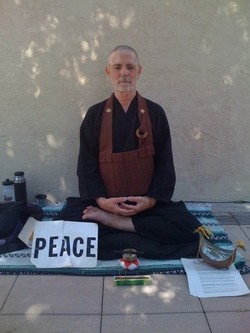Hi,
I am looking for someone who knows about posting on Wikipedia to make a page about Soto Teacher Daiho Hilbert Roshi. Anybody with the skills?
I think you know Daiho, one of the coolest Zen Dudes out there and a real friend of this place. Rev. Daiho is a very powerful and unique Soto Zen Teacher, a wounded Vietnam war veteran and social activist.


Daiho is in the Lineage of another great (if not so often mentioned for some strange reason) Japanese Soto Priest very important to Soto Zen in America. Soyu Matsuoka Roshi (1912-1997).
Here is Daiho's blog, and I hope you will also check out some of his beautiful and poignant commentary there ...
Daiho's Engaged Zen Blog
Please let me know.
Gassho, Jundo
I am looking for someone who knows about posting on Wikipedia to make a page about Soto Teacher Daiho Hilbert Roshi. Anybody with the skills?
I think you know Daiho, one of the coolest Zen Dudes out there and a real friend of this place. Rev. Daiho is a very powerful and unique Soto Zen Teacher, a wounded Vietnam war veteran and social activist.


Harvey Daiho Hilbert (born February 13, 1947) woke up to Zen after being shot in the head in combat in Vietnam in 1966. In spite of the resulting disability, Daiho went on to obtain a Masters and PH.D degree in Social Work and spent nearly thirty years offering contemplative practices to his clients. Daiho took up formal training in 1998 at Dharma Mountain Zendo in Cloudcroft, NM. He was ordained in 2000 and was given Dharma Transmission in 2005 by Ken Hogaku Shozen McGuire roshi.
In 2000 he was installed as abbot of Daibutsuji Zen Temple and re-established the Zen Center of Las Cruces. In 2005, he retired from his clinical practice and left Daibutsuji to establish the Order of Clear Mind Zen. The Order is based at Clear Mind Zen Temple in Las Cruces, New Mexico and currently has affiliates in northern California and west Texas. His practice includes street practice, daily blog postings of his teaching, as well as a fulltime monastic practice. His Temple offers daily Zazen, monthly Zazenkai, and quarterly Sesshin. In addition, it offers many educational group activities, as well as selected workshops specifically focused on recovery from war and violent trauma. Daiho is in a loving relationship with Kathryn Soku Shin Masaryk are working to establish a monastic residence together.
In 2000 he was installed as abbot of Daibutsuji Zen Temple and re-established the Zen Center of Las Cruces. In 2005, he retired from his clinical practice and left Daibutsuji to establish the Order of Clear Mind Zen. The Order is based at Clear Mind Zen Temple in Las Cruces, New Mexico and currently has affiliates in northern California and west Texas. His practice includes street practice, daily blog postings of his teaching, as well as a fulltime monastic practice. His Temple offers daily Zazen, monthly Zazenkai, and quarterly Sesshin. In addition, it offers many educational group activities, as well as selected workshops specifically focused on recovery from war and violent trauma. Daiho is in a loving relationship with Kathryn Soku Shin Masaryk are working to establish a monastic residence together.
Rev. Dr. Soyu Matsuoka-roshi (1912-1997) was a priest in a family of priests going back six centuries. He came to the United States in 1939 as an emissary of Sojiji Training Monastery first to Los Angeles, then to San Francisco. Matsuoka-roshi soon left San Francisco to go to New York where he worked with D T Suzuki at Columbia University. He then went to Chicago and established the Zen Buddhist Temple of Chicago in 1949.
Matsuoka taught everywhere he could: high schools, karate dojos, living rooms. He was relentless in his effort to bring the living Dharma to the United States. He wrote letters to newspapers, was a strong supporter of non-violence and de-segregation, and wrote letters in support of Rev. Martin Luther King’s civil disobedience.

Matsuoka-roshi taught Zazen. He taught basic forms. He chanted only the most essential sutras. He streamlined the training and progression of students so that they would have an opportunity to practice in roles and take on responsibilities they would not have been entitled to in an institutionalized context. His was a homegrown Zen, a practical Zen. He used Japanese terms sparingly and tried to make his Zen accessible to Americans.
Those who actually take the time to make a study of Matsuoka-roshi’s written record in two collections of his writings (“The Kyosaku” and “Moku-rai”) will soon discover the truth about this pioneer. He was a genuine Master and a fine teacher who held his students in higher esteem than they, themselves apparently did.
Matsuoka taught everywhere he could: high schools, karate dojos, living rooms. He was relentless in his effort to bring the living Dharma to the United States. He wrote letters to newspapers, was a strong supporter of non-violence and de-segregation, and wrote letters in support of Rev. Martin Luther King’s civil disobedience.

Matsuoka-roshi taught Zazen. He taught basic forms. He chanted only the most essential sutras. He streamlined the training and progression of students so that they would have an opportunity to practice in roles and take on responsibilities they would not have been entitled to in an institutionalized context. His was a homegrown Zen, a practical Zen. He used Japanese terms sparingly and tried to make his Zen accessible to Americans.
Those who actually take the time to make a study of Matsuoka-roshi’s written record in two collections of his writings (“The Kyosaku” and “Moku-rai”) will soon discover the truth about this pioneer. He was a genuine Master and a fine teacher who held his students in higher esteem than they, themselves apparently did.
Daiho's Engaged Zen Blog
Please let me know.
Gassho, Jundo


Comment